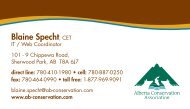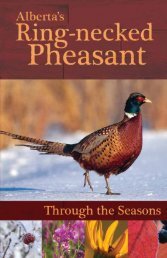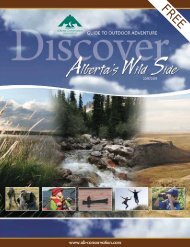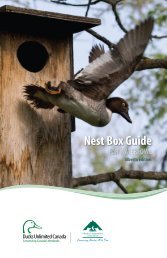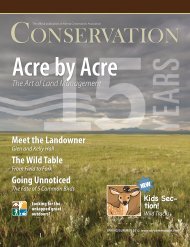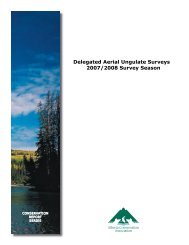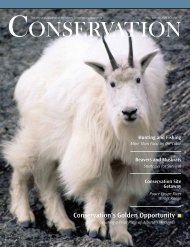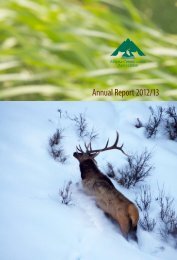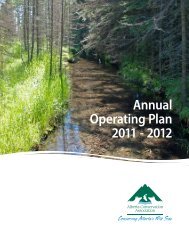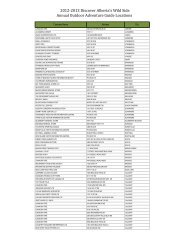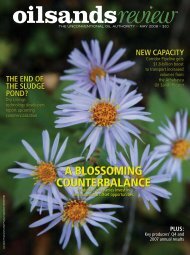Download PDF - Alberta Conservation Association
Download PDF - Alberta Conservation Association
Download PDF - Alberta Conservation Association
You also want an ePaper? Increase the reach of your titles
YUMPU automatically turns print PDFs into web optimized ePapers that Google loves.
The Suncor - Winagami Lake<br />
<strong>Conservation</strong> Project, 2003-2004<br />
CONSERVATION<br />
REPORT<br />
SERIES
The <strong>Alberta</strong> <strong>Conservation</strong> <strong>Association</strong> is a Delegated Administrative<br />
Organization under <strong>Alberta</strong>’s Wildlife Act.<br />
CONSERVATION<br />
REPORT<br />
SERIES<br />
25% Post Consumer Fibre<br />
When separated, both the binding and paper in this document are recyclable
The Suncor-Winagami Lake<br />
<strong>Conservation</strong> Project, 2003-2004<br />
Cedar Chittenden<br />
<strong>Alberta</strong> <strong>Conservation</strong> <strong>Association</strong><br />
Bag 900-26, 96 th Avenue<br />
Peace River, <strong>Alberta</strong> T8S 1T4<br />
Ed Kolodychuk<br />
<strong>Alberta</strong> <strong>Conservation</strong> <strong>Association</strong><br />
Bag 900-26, 96 th Avenue<br />
Peace River, <strong>Alberta</strong> T8S 1T4
GARRY J. SCRIMGEOUR<br />
<strong>Alberta</strong> <strong>Conservation</strong> <strong>Association</strong><br />
Baker Centre Postal Outlet<br />
P.O. Box 40027<br />
Edmonton, AB, T5J 4M9<br />
<strong>Conservation</strong> Report Series Types:<br />
Data & Technical<br />
ISBN printed: 0-7785-4105-3<br />
ISBN online: 0-7785-4106-1<br />
ISSN printed: 1712-2821<br />
ISSN online: 1712-283X<br />
Publication Number: T/085<br />
Report Series Co-editors<br />
DAVID FAIRLESS<br />
<strong>Alberta</strong> <strong>Conservation</strong> <strong>Association</strong><br />
7 th Floor O.S. Longman Building<br />
6909-116 Street<br />
Edmonton, AB, T6H 4P2<br />
Disclaimer: This document is an independent report prepared by the <strong>Alberta</strong><br />
<strong>Conservation</strong> <strong>Association</strong>. The authors are solely responsible for the interpretations of<br />
data and statements made within this report.<br />
Reproduction and Availability: This report and its contents may be reproduced in<br />
whole, or in part, provided that this title page is included with such reproduction and/or<br />
appropriate acknowledgements are provided to the authors and sponsors of this project.<br />
Suggested citation:<br />
Chittenden, C., Kolodychuk, E. 2005. The Suncor-Winagami Lake <strong>Conservation</strong> Project,<br />
2003-2004. Data report, D-2004-013, produced by <strong>Alberta</strong> <strong>Conservation</strong><br />
<strong>Association</strong>, Peace River, <strong>Alberta</strong>, Canada. 14 pp. + Apps.<br />
Cover photo credit: David Fairless<br />
Content photo credit: C .Chittenden & E. Kolodychuk<br />
Digital copies of conservation reports can be obtained from:<br />
<strong>Alberta</strong> <strong>Conservation</strong> <strong>Association</strong><br />
P.O. Box 40027, Baker Centre Postal Outlet<br />
Edmonton, AB, T5J 4M9<br />
Toll Free: 1-877-969-9091<br />
Tel: (780) 427-5192<br />
Fax: (780) 422-6441<br />
Email: info@ab-conservation.com<br />
Website: www.ab-conservation.com<br />
ii
EXECUTIVE SUMMARY<br />
The Suncor-Winagami Project (2003) was a pilot project initiated by Suncor Energy Inc.<br />
who requested staff with <strong>Alberta</strong> Parks and Protected Areas to recommend a nongovernment,<br />
non-profit conservation organization that could purchase land to offset the<br />
hectares impacted by Suncor’s Oil Sands Operations in Fort McMurray, <strong>Alberta</strong>. The<br />
<strong>Alberta</strong> <strong>Conservation</strong> <strong>Association</strong> was subsequently identified as the candidate<br />
organization by <strong>Alberta</strong> Parks and Protected Areas and was asked to submit a proposal<br />
to Suncor Energy Inc. so that they could be considered as the lead organization to secure<br />
land. Given its broad conservation mandate and its expertise with land securement, the<br />
<strong>Alberta</strong> <strong>Conservation</strong> <strong>Association</strong> was subsequently selected as the lead organization to<br />
secure land to offset the areas impacted by Suncor’s Oil Sands Operations in Fort<br />
McMurray, <strong>Alberta</strong>.<br />
Through collaborative efforts with <strong>Alberta</strong> Parks and Protected Areas, and the Suncor<br />
Energy Foundation, the ACA secured 470 acres of land adjacent to Winagami Lake in<br />
northwest <strong>Alberta</strong>. These purchases were preceded by intensive communication efforts<br />
to contact all landowners and lessees of lakeshore parcels in July of 2003 to provide them<br />
with information about habitat conservation and the land securement project. Fifty<br />
percent of those contacted agreed to sell their land, which in the future will be<br />
incorporated and protected within the Winagami Lake Wildland and Provincial Parks.<br />
Since ACA began conservation work at Winagami Lake in 1985, over eighty percent of<br />
the once grazed shoreline has been conserved for wildlife and fisheries.<br />
iii
ACKNOWLEDGEMENTS<br />
We are grateful to the following individuals, agencies, and corporations for their<br />
contributions and assistance in delivering the project. In particular, we thank the Suncor<br />
Energy Foundation for their substantial donation to secure the land. Ducks Unlimited<br />
Canada also contributed funds and time required to purchase some of the land. We<br />
thank Simon Geoghegan, John Vanderbeek and Don Klym, of Suncor Energy Inc. for<br />
initiating this project, along with Archie Landals of <strong>Alberta</strong> Parks and Protected Areas.<br />
We also thank Trish Hill, Chad Sherburne, Al Benson, Kari White, Brendan Kowalenko,<br />
Dave Moyles and David Derosa (<strong>Alberta</strong> Sustainable Resource Development) for<br />
donating their time, maps and expertise. Finally, we thank the ACA Northwest Habitat<br />
Team for their feedback and assistance and Garry Scrimgeour for his review of an earlier<br />
draft of this report.<br />
iv
TABLE OF CONTENTS<br />
EXECUTIVE SUMMARY ........................................................................................................... iii<br />
ACKNOWLEDGEMENTS ......................................................................................................... iv<br />
TABLE OF CONTENTS...............................................................................................................v<br />
LIST OF FIGURES ....................................................................................................................... vi<br />
1.0 INTRODUCTION.............................................................................................................. 1<br />
1.1 Study Rationale .............................................................................................................. 1<br />
1.2 Objectives ........................................................................................................................ 1<br />
2.0 STUDY AREA .................................................................................................................... 1<br />
3.0 ACTIVITIES COMPLETED IN 2003-2004...................................................................... 5<br />
3.1 Objective 1 - Securing Land.......................................................................................... 5<br />
3.2 Objective 2 – Project communications ......................................................................... 9<br />
3.3 Objective 3 – Focal areas for conservation in <strong>Alberta</strong>’s Boreal forest.................... 11<br />
4.0 FUTURE CONSIDERATIONS....................................................................................... 11<br />
4.1 Lands purchased in 2003.............................................................................................. 11<br />
4.2 Focus Areas for 2004-2007 ............................................................................................ 12<br />
5.0 LITERATURE CITED...................................................................................................... 14<br />
6.0 APPENDICES................................................................................................................... 15<br />
Appendix 1. Newspaper Article on Habitat <strong>Conservation</strong>............................................... 15<br />
Appendix 2. Newspaper Article on ACA-Suncor-Parks Partnership ............................. 17<br />
Appendix 3. Sign created to identify property sites .......................................................... 18<br />
Appendix 5. The Winagami-O’Mahony property management plan............................. 29<br />
Appendix 6. The Winagami-Turner/Axsen property management plan ....................... 38<br />
v
LIST OF FIGURES<br />
Figure 1. Location of Winagami Lake (red star) in northwest <strong>Alberta</strong>............................. 2<br />
Figure 2. A view of Winagami Lake from its east shore..................................................... 3<br />
Figure 3. A view of Winagami Lake Provincial Park from the breakwater..................... 3<br />
Figure 4. Bald eagle perched in a tree located on the south shore of Winagami Lake... 4<br />
Figure 5.<br />
Figure 6.<br />
Figure 7.<br />
Figure 8.<br />
Figure 9.<br />
Land use adjacent to Winagami Lake, <strong>Alberta</strong>. Provincial Parks are shown<br />
in purple, freehold land in yellow, grazing leases are shown in red and<br />
annual grazing permits are shown in orange. ..................................................... 4<br />
Location of the Winagami-Bisson property located on the northwest shore of<br />
Winagami Lake, <strong>Alberta</strong>. Area is highlighted in yellow.................................... 6<br />
Location of the Winagami-O’Mahony Property located on the west shore of<br />
Winagami Lake, <strong>Alberta</strong>. Area is highlighted in yellow.................................... 7<br />
Location of the Winagami-Turner/Axsen property located on the southeast<br />
shore of Winagami Lake, <strong>Alberta</strong>. Area is highlighted in yellow..................... 8<br />
Participants in the Winagami Lake project media day. Left to right: Don<br />
Klym (Suncor Energy), Simon Geoghegan (Suncor Energy), Archie Landals<br />
(<strong>Alberta</strong> Parks and Protected Areas), John Vanderbeek (Suncor Energy),<br />
Steven Hull (ACA-Managing Director), Cedar Chittendan (ACA), Jan<br />
Young(ACA), Ken Zurfluh (<strong>Alberta</strong> Parks and Protected Areas), Dave<br />
Crooks (<strong>Alberta</strong> Parks and Protected Areas). .................................................... 10<br />
Figure 10. Simon Geoghegan and John Vanderbeek of Suncor Energy, and Archie<br />
Landals <strong>Alberta</strong> Parks and Protected Areas, participating in the boat tour of<br />
Wingami Lake, 2003. ............................................................................................. 10<br />
Figure 11. The Wingami Lake project partners celebrated the property purchases with a<br />
media event and evening barbeque. ................................................................... 11<br />
Figure 12. Map of the Winagami Lake Plain Area, delineated in red............................... 12<br />
vi
1.0 INTRODUCTION<br />
1.1 Study Rationale<br />
Suncor Energy selected <strong>Alberta</strong> <strong>Conservation</strong> <strong>Association</strong> to purchase land for<br />
conservation in the boreal region to replace habitat impacted by their Oil Sands<br />
Operations in Fort McMurray, <strong>Alberta</strong>. The Winagami Lake area was chosen as the<br />
candidate area for the land purchase because of its high conservation value including its<br />
importance to fisheries and wildlife conservation. Only a few of the lakeshore parcels<br />
remained freehold and the majority of currently held under grazing leases, these were<br />
identified for potential purchase in 2003. The potential purchase of lands adjacent to<br />
Winagami Lake was also deemed to be well aligned with the goals of <strong>Alberta</strong> Parks and<br />
Protected Areas and the <strong>Alberta</strong> <strong>Conservation</strong> <strong>Association</strong>..<br />
1.2 Objectives<br />
Our objectives for 2003 were to:<br />
1) Acquire as many of the remaining lakeshore parcels as funding would permit on<br />
Winagami Lake for inclusion into the Winagami Lake Provincial Park system. This<br />
was to be accomplished by purchasing freehold lands and securing leased crown<br />
lands with protective land use reservations.<br />
2) Host a Winagami Lake event and media day to highlight the importance of habitat<br />
conservation and the important role that habitat securement can play to achieve<br />
habitat conservation gaols. Newspaper articles, signage of the property securement,<br />
and a final showcase of the project, were organized to increase public awareness for<br />
this project and Suncor Energy’s contribution to land conservation.<br />
3) Develop a larger three-year land conservation plan for areas of the boreal forest. This<br />
proposal was submitted to the Suncor Energy Foundation upon completion of the<br />
pilot project to assist them to evaluate the merits of adopting a collaborative and<br />
integrated land securement plan that could achieve conservation goals at a large<br />
spatial scale.<br />
2.0 STUDY AREA<br />
Winagami Lake (Figures 1) is located approximately five kilometers southeast of the<br />
town of McLennan, and twenty kilometers northwest of High Prairie. The lake supports<br />
important commercial and recreational fisheries, as well as valuable wildlife and<br />
waterfowl habitat. While the lake is considered to have high conservation value, its<br />
current condition has greatly improved over the last fifteen years when the majority of<br />
the shoreline was heavily impacted by livestock grazing. In addition, water levels were<br />
1
critically low and riparian areas were in poor condition. After years of combined efforts<br />
from <strong>Alberta</strong> <strong>Conservation</strong> <strong>Association</strong> and <strong>Alberta</strong> Sustainable Resource Development,<br />
Winagami’s shoreline is almost completely protected in Winagami Lake Provincial Park<br />
(Figures 2, 3) and grazing is no longer permitted along the lakeshore.<br />
The lake was stocked with walleye in 1991, and from 1994 to 1996, and spawning bed<br />
enhancements were made in 1992 and 1995. Fish populations and angling pressures are<br />
monitored regularly at the lake. Over two hundred species of birds each year, including<br />
western grebes, bald eagles and white pelicans are known to occur at the Winagami<br />
Lake area (Figure 4). The Winagami Lake Wildland Provincial Park, created in 2000,<br />
encompasses over 30,000 acres of wetland and wooded fen. The existing Winagami<br />
Lake Provincial Park boundaries were also expanded in 2000; together, Winagami’s<br />
protected areas now include over 160 square kilometers (Figure 5).<br />
High Level<br />
Peace River<br />
Grande Prairie<br />
Slave Lake<br />
Figure 1.<br />
Location of Winagami Lake (red star) in northwest <strong>Alberta</strong>.<br />
2
Figure 2.<br />
A view of Winagami Lake from its east shore.<br />
Figure 3.<br />
A view of Winagami Lake Provincial Park from the breakwater.<br />
3
Figure 4.<br />
Bald eagle perched in a tree located on the south shore of Winagami Lake.<br />
Figure 5.<br />
Land use adjacent to Winagami Lake, <strong>Alberta</strong>. Provincial Parks are shown<br />
in purple, freehold land in yellow, grazing leases are shown in red and<br />
annual grazing permits are shown in orange.<br />
4
3.0 ACTIVITIES COMPLETED IN 2003-2004<br />
3.1 Objective 1 - Securing Land<br />
Approximately 470 acres of Winagami lakeshore were conserved with Suncor Energy<br />
Foundation funding in 2003-2004. Project staff initiated an intensive communication<br />
program to meet and discuss the project objectives with all owners of parcels of<br />
lakeshore property were contacted in July of 2003 and with representatives from <strong>Alberta</strong><br />
Public Lands. These discussions included an evaluation of the willingness of land lessees<br />
to relinquish their current grazing leases. Appraisals were ordered for interested<br />
parties, and negotiations were carried out between July to December 2003. These efforts<br />
lead to the completion of three successful land deals, which included areas from five<br />
quarters. The following are descriptions of the parcels and their locations:<br />
Parcel 1 - The Winagami-Bisson Property<br />
The Winagami-Bisson Property located at SE22, SE23, and NE14-77-19-W5M contains<br />
330 acres of mostly cleared land (Figure 6). This property was grazed historically, but<br />
will be left to revert back to native wetland and woodland habitat. Ducks Unlimited<br />
Canada donated funds towards the purchase and will assist with monitoring. The land<br />
will be incorporated into the Winagami Lake Wildland Park.<br />
Parcel 2 - The Winagami-O’Mahony Property<br />
The Winagami-O’Mahony Property located at SW1-77-19-W5M contains 30 acres of<br />
pristine wooded habitat (Figure 7). Bordered on all sides by Winagami Lake Provincial<br />
Park (specifically, the Winagami <strong>Conservation</strong> Area), this land has interpretive trails<br />
running through it, and was formerly owned by the creator of the Winagami<br />
<strong>Conservation</strong> Area, John O’Mahony. This area will be left as a natural area, and Mr.<br />
O’Mahony will continue to provide voluntary stewardship and trail maintenance. This<br />
land will eventually be incorporated into the Winagami Lake Provincial Park.<br />
Parcel 3 - The Winagami-Turner/Axsen Property<br />
The Winagami-Turner/Axsen Property located at NW23-76-18-W5M (Figure 8) contains<br />
116 acres of mixed wetland/wooded/meadow habitat that will continue to be hayed until<br />
2009 in accordance with the land purchase deal. A house and ten acres was subdivided<br />
off the property on the south border and the remainder will revert to native waterfowl<br />
nesting habitat and incorporated into the Winagami Lake Provincial Park.<br />
5
Figure 6.<br />
Location of the Winagami-Bisson property located on the northwest shore of<br />
Winagami Lake, <strong>Alberta</strong>. Area is highlighted in yellow.<br />
6
Figure 7.<br />
Location of the Winagami-O’Mahony Property located on the west shore of<br />
Winagami Lake, <strong>Alberta</strong>. Area is highlighted in yellow.<br />
7
Figure 8.<br />
Location of the Winagami-Turner/Axsen property located on the southeast<br />
shore of Winagami Lake, <strong>Alberta</strong>. Area is highlighted in yellow.<br />
8
3.2 Objective 2 – Project communications<br />
The focus and goals of the Winagami Lake conservation project were communicated to<br />
focal groups using a combination of news articles and a media event. The first of two<br />
newspaper articles represented a general habitat conservation article published in the<br />
Peace River Record-Gazette on 21 October 2003 (Appendix 1) whereas the second article<br />
profiled the Suncor-ACA-<strong>Alberta</strong> Parks partnership and the Winagami Lake Project<br />
(Appendix 2). The second article will be sent to twelve local newspapers following the<br />
March 2004 media event. This event will be held in Edmonton for Suncor stakeholders,<br />
the public and dignitaries to showcase the project and Suncor’s initiative in sustainable<br />
resource development. An article featured in ACA’s November 2004 issue of<br />
<strong>Conservation</strong> also highlighted the project.<br />
Additional communication efforts included the development of signs advertising the<br />
project and project sites (Appendix 3) and will be installed in June 2005/06. A pamphlet<br />
titled “Habitat <strong>Conservation</strong>” as well as a “Winagami Lake Project” insert were created<br />
and were distributed to landowners and lessees.<br />
Winagami Lake Day, an event that brought ACA, Suncor and Parks together for a BBQ<br />
and boat tour of the lake in September 2003, represented an effective opportunity to<br />
communicate the short and long term goals of the project and the partnerships between<br />
the <strong>Alberta</strong> <strong>Conservation</strong> <strong>Association</strong>, Suncor and <strong>Alberta</strong> Parks. This event fostered an<br />
improved the understanding of issues related to habitat conservation (Figure 9, 10, 11).<br />
Partners were provided with photo albums of the land parcels that were under<br />
negotiation, as well as information sheets and project pamphlets.<br />
9
Figure 9.<br />
Participants in the Winagami Lake project media day. Left to right: Don Klym<br />
(Suncor Energy), Simon Geoghegan (Suncor Energy), Archie Landals (<strong>Alberta</strong><br />
Parks and Protected Areas), John Vanderbeek (Suncor Energy), Steven Hull<br />
(ACA-Managing Director), Cedar Chittendan (ACA), Jan Young(ACA), Ken<br />
Zurfluh (<strong>Alberta</strong> Parks and Protected Areas), Dave Crooks (<strong>Alberta</strong> Parks and<br />
Protected Areas).<br />
Figure 10. Simon Geoghegan and John Vanderbeek of Suncor Energy, and Archie Landals<br />
of <strong>Alberta</strong> Parks and Protected Areas, participating in the boat tour of Wingami<br />
Lake, 2003.<br />
10
Figure 11. The Wingami Lake project partners celebrated the property purchases with a<br />
media event and evening barbeque.<br />
3.3 Objective 3 – Focal areas for conservation in <strong>Alberta</strong>’s Boreal forest<br />
Meetings were held with representatives of Suncor, <strong>Alberta</strong> Parks and the ACA to<br />
compile a list of boreal habitat focus areas. The 2004-2007 project proposal and the<br />
Suncor Boreal Habitat Replacement Project document were written collaboratively by<br />
<strong>Alberta</strong> Parks and ACA. The proposal was submitted to the Suncor Energy Foundation<br />
in February of 2004 and the document, outlining the boreal focus areas and project goals,<br />
was sent out to all partners.<br />
4.0 FUTURE CONSIDERATIONS<br />
4.1 Lands purchased in 2003<br />
Lands purchased in 2003 for the Suncor-Winagami Project will be left to revert back to<br />
native habitat, and will eventually be incorporated into the Winagami Lake park system.<br />
To assist with land management, management plans were developed for each of the<br />
three properties (Appendices 4, 5 and 6).<br />
11
4.2 Focus Areas for 2004-2007<br />
If land securement activities are funded by Suncor as part of an ongoing partnership<br />
with the ACA and <strong>Alberta</strong> parks, we recommend that funding be directed to purchase<br />
properties in the The Kimiwan / Winagami / South Heart River areas. Purchases of lands<br />
in these areas would resulting in the conservation of critical wildlife, waterfowl, and<br />
fisheries habitat from the Kimiwan lakeshore to the Winagami and Lesser Slave Lake<br />
Parks (Figure 12). Additionally, it would create landscape continuity, effectively<br />
restoring riparian areas, reducing habitat fragmentation, and stabilizing water levels in<br />
the area. This area lies within the Winagami Lake Plain, a wetland subregion ranked as<br />
being of national importance for colonial nesting species, and staging waterfowl and<br />
shorebirds (Poston et. al, 1990). It also contains critical spawning areas for the northern<br />
pike and walleye of Winagami and Lesser Slave Lakes.<br />
Figure 12. Map of the Winagami Lake Plain Area, delineated in red.<br />
12
Land acquisition efforts for 2004-07 will be focused in the Winagami Lake Plain Area, as<br />
well as the following other locations (Chittenden et al. 2004):<br />
• Lesser Slave Lake<br />
• Sturgeon Lake<br />
• The Beaverlodge Drainage<br />
• Big Lake<br />
• Cold Lake<br />
• Rochester / Newbrook / Tawatinaw<br />
• Athabasca River (Fort Assiniboine, Hubert Lake)<br />
13
5.0 LITERATURE CITED<br />
Chittenden, C., Landals, A., Young, J. 2004. The Suncor Boreal Habitat Replacement<br />
Project (2004-07 Boreal Habitat Strategy). <strong>Alberta</strong> <strong>Conservation</strong> <strong>Association</strong> and<br />
<strong>Alberta</strong> Community Development - Parks and Protected Areas. Peace River,<br />
Edmonton, and St. Paul, AB.<br />
Poston, B., Ealey, D.M., Taylor, P.S., and McKeating, G.B. 1990. Priority Migratory Bird<br />
Habitats of Canada’s Prairie Provinces. Canadian Wildlife Services report.<br />
116pp.<br />
14
6.0 APPENDICES<br />
Appendix 1. Newspaper Article on Habitat <strong>Conservation</strong><br />
Own Land? Create a Legacy!<br />
Q: I own a forested quarter of land in northern <strong>Alberta</strong>, full of wildlife and wetlands. I<br />
would like to continue living on my land, and hope that my children will be able to<br />
enjoy it as well, but I want to be certain that it won’t be subdivided and developed one<br />
day. How can I do this?<br />
<strong>Alberta</strong> has been entrusted with a natural legacy --one over which landowners hold the<br />
most control. Today, thanks to the efforts of many conservation-minded <strong>Alberta</strong>ns,<br />
powerful land protection tools are available to landowners like you.<br />
<strong>Conservation</strong> easements enable landowners to maintain ownership while receiving<br />
financial benefits and ensuring the preservation of their natural area for future<br />
generations. <strong>Alberta</strong>’s Environmental Protection and Enhancement Act was amended in<br />
1996 to include legislation for conservation easements. These legal agreements can be<br />
donated or sold to conservation organizations; once an easement is established, that<br />
piece of land can no longer be developed. After the land value has been reassessed,<br />
property and estate taxes should decrease thereon, and if the easement was donated, its<br />
value may be claimed as an Ecogift under Canada’s Ecological Gifts Program (see<br />
donations).<br />
Donations of important natural areas may be claimed against 100% of donors’ net<br />
annual income, with the surplus carrying over for up to five years. Canada’s Ecological<br />
Gifts Program, created in 1995, provides tax breaks to encourage Canadians to donate<br />
land or partial interests in land that have been deemed ecologically sensitive. Some<br />
conservation organizations may also be interested in purchasing your land outright, or<br />
paying part of the total value and offering charitable donation receipts for the<br />
remainder. Another possibility is a lifetime tenancy agreement, which allows<br />
landowners to live on the land after giving up ownership.<br />
Responsible land stewardship<br />
Landowners are the stewards of millions of creatures, from bacteria to bears. As<br />
<strong>Alberta</strong>’s natural habitat is eliminated, species diversity is lost forever. However, there<br />
are many ways to reverse this process –-and you can start in your own backyard!<br />
If your land borders a water body, care should be taken to keep the surrounding<br />
riparian areas healthy. Buffer zones should be maintained to stabilize the banks, clean<br />
the water, and provide cover for wildlife and fish. Fencing cattle back from shorelines,<br />
and digging diversion ditches can eliminate fertilizer and manure runoff. Other<br />
polluting activities such as washing vehicles or pets in the water, or the dumping of<br />
15
chemicals should be avoided at all costs. Other ways to enhance backyard conservation<br />
include allowing woodlands, wetlands and native grasslands to remain natural,<br />
enlarging and planting new shelterbelts, building nest boxes and feeders for birds, and<br />
planting attractants for butterflies and hummingbirds, such as lilacs, hollyhocks, and<br />
butterfly bushes.<br />
Landowners play a vital role in conserving our natural heritage and unbroken<br />
landscapes for future generations. No other group of individuals has a greater influence<br />
on our landscapes and the wildlife they support, on our water and air quality, on the<br />
health of our province. For more information on ways that you can protect the natural<br />
features of your land and begin your own conservation legacy, contact your local<br />
<strong>Alberta</strong> <strong>Conservation</strong> <strong>Association</strong> office.<br />
16
Appendix 2. Newspaper Article on ACA-Suncor-Parks Partnership<br />
Suncor/ACA Collaboration Leads to <strong>Conservation</strong><br />
<strong>Conservation</strong> work in our area is being supported by Suncor Energy’s goal of becoming<br />
a sustainable energy company. In the spring of 2003, a partnership was formed between<br />
the Suncor Energy Foundation, <strong>Alberta</strong> Parks and Protected Areas, and <strong>Alberta</strong><br />
<strong>Conservation</strong> <strong>Association</strong> (ACA) to effectively protect ecologically valuable land in<br />
<strong>Alberta</strong>’s boreal region. Winagami Lake was selected as a focus area, and groundwork<br />
began in July of 2003.<br />
Winagami Lake and its surrounding watershed are recognized as critical habitat to<br />
many plant and animal species. Over two hundred species of birds, including western<br />
grebes, bald eagles and white pelicans, depend on the area for foraging and nesting. The<br />
lake itself is also an important sport fishery, with a popular campground and boat<br />
launch for public use.<br />
Back in 1985, Winagami’s shoreline was mostly grazed. Over the past fifteen years,<br />
ACA, with support from <strong>Alberta</strong> Sustainable Resource Development, has been<br />
successful in reverting approximately 80% of those grazed lands back to native fisheries<br />
and wildlife habitat through collaboration with landowners and lessees. In 2000,<br />
<strong>Alberta</strong> Parks expanded the protected areas at Winagami Lake to include some of these<br />
lands, and expand the park area to over 160 square kilometers.<br />
Last year (2003), the Suncor Energy Foundation made a donation to support the<br />
conservation of the remaining parcels of freehold and crown land around the lake. By<br />
working with land managers, landowners and lessees, ACA was able to conserve 470<br />
acres of lakeshore, which will be incorporated into the park system.<br />
Suncor’s initiative is helping to minimize habitat fragmentation at Winagami Lake. This<br />
proactive leader of industry is reducing its impact on the environment and creating<br />
sustainable resource use strategies for the future, effectively improving the long-term<br />
health of our environment, economy, and people.<br />
17
Appendix 3. Sign created to identify property sites<br />
<strong>Conservation</strong> of this site<br />
was accomplished by the<br />
collaborative efforts of<br />
18
Appendix 4. The Winagami-Bisson property management plan<br />
The Winagami-Bisson Property<br />
Management Plan<br />
(NE14, SE22, SE23-77-19-W5M)<br />
Cedar Chittenden, Ed Kolodychuk<br />
<strong>Alberta</strong> <strong>Conservation</strong> <strong>Association</strong><br />
Northwest Business Unit<br />
19
Management Plan for Winagami-Bisson Property<br />
(NE14, SE22, SE23-77-19-W5M)<br />
Introduction<br />
In 2003, <strong>Alberta</strong> <strong>Conservation</strong> <strong>Association</strong> (ACA) purchased the Winagami-Bisson<br />
Property in a cooperative partnership with the Suncor Energy Foundation and <strong>Alberta</strong><br />
Community Development. This partnership established a Boreal Land Acquisition Pilot<br />
Project to purchase land at Winagami Lake in 2003. Suncor, Parks, and ACA agree that<br />
this property is to be managed for the purpose of protecting native boreal mixed wood<br />
vegetation and wildlife habitat. Ducks Unlimited Canada (DUC) contributed towards<br />
the purchase of SE23-77-19-W5 and placed a conservation easement on the property to<br />
protect their interests in the land.<br />
ACA initiated the Winagami Lake Project to preserve sensitive riparian areas around the<br />
lake. Vegetation damage and runoff from human activities, including agriculture and<br />
livestock grazing, contribute to bank erosion and reduce riparian health and water<br />
quality. During 1985, over half of the lakeshore was grazed. Over the last fifteen years,<br />
ACA and <strong>Alberta</strong> Sustainable Resource Development (ASRD) have combined efforts to<br />
reduce shoreline damage, improve spawning sites, stock walleye and monitor sport fish<br />
populations in the lake. The expanded Winagami Lake Provincial Park boundaries, and<br />
the newly established Winagami Wildland Park encompass over 160 square kilometers.<br />
This was achieved through the previous conservation efforts of ACA and ASRD. In<br />
2003, ACA received funding from Suncor Energy Foundation to continue conserving the<br />
remaining lakeshore habitat.<br />
Property Description<br />
The property (NE14, SE22, SE23-77-19-W5M) is found in M.D. #130 of Smoky River and<br />
is located approximately two kilometers southeast of the town of McLennan, <strong>Alberta</strong><br />
(Figures 1, 2). The lands are situated in the white zone and are adjacent to Winagami<br />
Lake and Winagami Lake Provincial Park. The lands are partly cleared and were<br />
historically grazed. Native wetlands exist on the property, with some forested areas,<br />
and several unique habitat types.<br />
Winagami Lake is a valuable sport fishery, with populations of walleye, pike, lake<br />
whitefish and yellow perch. The Bissons and ACA staff have observed numerous<br />
wildlife species including deer, beaver, several species of small fur-bearers, songbirds<br />
and waterfowl.<br />
1) NE14-77-19-W5M (crown)<br />
The northeast quarter of section 14 contains native wetlands and grasslands. This<br />
area was also formerly leased for grazing as part of a grazing lease and is<br />
excellent nesting habitat for waterfowl (Figure 3).<br />
20
2) SE 22-77-19-W5M (crown)<br />
The southeast quarter of section 22 is fenced on the north and west sides and is<br />
mainly clear with few stands of aspen (Figure 4). On the east side, the property<br />
touches Winagami Lake, and the canal to Kimiwan intersects the southeast<br />
corner (Figure 5). This quarter was formerly leased for grazing as part of a<br />
grazing lease.<br />
3) SE23-77-19-W5M (titled)<br />
The southeast quarter of section 23 is cleared with some limited aspen-spruce<br />
stands. This land is fenced on the north (Figure 6,) east, and south sides, with a<br />
corral built next to the south fence (Figure 7). The west half of this titled quarter<br />
is fairly wet and has scattered wetlands supporting excellent waterfowl habitat.<br />
Figure 1.<br />
Map showing the Winagmi-Bisson Property’s location (NE14, SE22, SE23-77-<br />
19W5M) Winagami Lake.<br />
21
Crown<br />
lease<br />
Title<br />
Crown<br />
lease<br />
Figure 2.<br />
Air Photo (May 31, 2001). This aerial photograph illustrates the location of<br />
the Winagami-Bisson Property (NE14, SE22, SE23-77-19-W5M) in relation to<br />
Winagami Lake and surrounding habitat.<br />
22
Figure 3. NE14-77-19-W5 view of the south fence line, facing northeast.<br />
23
Figure 4. Aspen stand on SE22-77-19-W5M. Area was historically grazed by the lessee.<br />
Figure 5.<br />
Southwest corner of SE22-77-19-W5M, facing southeast along the canal.<br />
Heavily grazed by the lessee.<br />
24
Figure 6. East perimeter fence of SE23-77-19-W5M, facing north.<br />
Figure 7. South fence and corral of SE23-77-19-W5M, facing north.<br />
25
Property objectives<br />
The property was acquired with the purpose of conserving and reverting the shoreline<br />
and upland habitat, eventually incorporating it into the Winagami Lake Wildland<br />
Provincial Park.<br />
The objectives of the property are to:<br />
1. Conserve and maintain the native forest cover and riparian habitat for wildlife.<br />
2. Conserve and maintain the diversity of habitats for the benefit of numerous wildlife<br />
species.<br />
3. Provide recreational opportunities such as wildlife viewing, hunting, angling,<br />
hiking, berry picking, etc.<br />
4. Allow the property to be incorporated into the Winagami Lake Wildland Provincial<br />
Park.<br />
5. Protect and maintain riparian areas to enhance the sport fishery and water quality in<br />
the lake.<br />
Management plan<br />
It is the intent of ACA and partners to manage the Winagami-Bisson Property in such a<br />
way as to protect and maintain the rich diversity of native habitats, which will provide<br />
high quality fisheries and wildlife habitat.<br />
Habitat management<br />
1.1 Woodlands<br />
The woodlands on this property will be retained as native forest cover. The mature<br />
forest cover presently provides excellent thermal cover for wildlife and will grow back<br />
naturally in areas that have been disturbed. The understory provides excellent browse<br />
for ungulates and berries for songbirds, upland birds and bears. The mixed forest stand<br />
provides excellent habitat for many species of small fur-bearers including red squirrel,<br />
marten, fisher and weasel.<br />
The woodlands on this property require no future maintenance, as they will be<br />
left to revert back to their natural state.<br />
26
1.2 Wetlands<br />
DUC and ACA will be involved with managing the seasonal wetlands and maintaining<br />
them as waterfowl habitat. Semi-annual inspections will be made by ACA and/or DUC<br />
to ensure that areas continue to support healthy populations of waterfowl.<br />
1.3 Riparian<br />
The riparian areas on this property will be left in their natural state.<br />
Weed control will be carried out by ACA and DUC, as deemed necessary through semiannual<br />
inspections.<br />
1.4 Cleared lands<br />
There are cleared lands on 23SE and 22SE that have been seeded for grazing. These<br />
areas would naturally be wooded, therefore they will be left to re-seed naturally and<br />
grow back. Weed control will be carried out by ACA and DUC as deemed necessary by<br />
semi-annual inspections. DUC will manage these lands for waterfowl nesting cover.<br />
Wildlife management<br />
The management of wildlife will include maintaining a variety of wildlife species on<br />
these lands. Many deer, moose and small fur-bearers frequent the property; the close<br />
proximity of these lands to Winagami and Kimiwan Lakes make it valuable to a variety<br />
of songbirds and waterfowl. These lands will be allowed to continue supporting<br />
waterfowl and wildlife best through the idling of the native habitat. DUC may wish to<br />
conduct waterfowl surveys and nesting success as required or deemed necessary.<br />
Public use management<br />
3.1 Wildlife viewing opportunities<br />
Foot access only will be permitted to all areas of the property for photography and<br />
wildlife viewing. These activities may occur year round, as they will have little impact<br />
on the wildlife and habitat. Foot access signs may be installed along the south perimeter<br />
of the property along the road.<br />
3.2 Hunting & trapping<br />
Hunting and trapping will be permitted on these lands on foot under the authority of an<br />
appropriate hunting license or trapping permit. Upon request for trapping privileges,<br />
partners will be notified.<br />
27
3.3 Off Highway vehicle use<br />
ATV access will be permitted on the property for the former landowner, Euclide Bisson,<br />
who will act as a land steward. Once these lands become part of the Winagami Wildland<br />
Provincial Park, a park management plan will be required and these conditions will<br />
need to be reviewed further.<br />
Special Issues<br />
4.1 Resource extraction<br />
The establishment of any industrial activity, including access development onto this<br />
property would compromise management objectives. Any activities such as oil and gas<br />
exploration, seismic and the construction of pipelines, power lines and buildings will be<br />
discouraged.<br />
Implementation of the management plan<br />
ACA and DUC will manage the land in accordance with the Management Plan, and<br />
modifications to the Management Plan as may be developed from time to time.<br />
Modifications to the Management Plan must be reviewed and approved by the partner<br />
organizations.<br />
28
Appendix 5. The Winagami-O’Mahony property management plan<br />
The Winagami-O’Mahony Property<br />
Management Plan<br />
(SW1-77-19-W5M)<br />
Cedar Chittenden, Ed Kolodychuk<br />
<strong>Alberta</strong> <strong>Conservation</strong> <strong>Association</strong><br />
Northwest Business Unit<br />
29
Management Plan for Winagami-O’Mahony Property<br />
(SW1-77-19-W5M)<br />
Introduction<br />
In 2003, <strong>Alberta</strong> <strong>Conservation</strong> <strong>Association</strong> (ACA) purchased Winagami-O’Mahony<br />
Property (SW1-77-19-W5M) in a cooperative partnership with the Suncor Energy<br />
Foundation and <strong>Alberta</strong> Community Development. This partnership established a<br />
Boreal Land Acquisition Pilot Project to purchase land at Winagami Lake in 2003.<br />
Suncor, Parks, and ACA agree that this property is to be managed for the purpose of<br />
protecting native boreal mixed wood vegetation and wildlife habitat.<br />
ACA initiated the Winagami Lake Project to preserve sensitive riparian areas around the<br />
lake. Vegetation damage and runoff from human activities, including agriculture and<br />
livestock grazing, contribute to bank erosion and reduce riparian health and water<br />
quality. During 1985, over half of the lakeshore was grazed. Over the last fifteen years,<br />
ACA and <strong>Alberta</strong> Sustainable Resource Development (ASRD) have combined efforts to<br />
reduce shoreline damage, improve spawning sites, stock walleye and monitor sport fish<br />
populations in the lake. The expanded Winagami Lake Provincial Park boundaries, and<br />
the newly established Winagami Wildland Park encompass over 160 square kilometers.<br />
This was achieved through the previous conservation efforts of ACA and ASRD. In<br />
2003, ACA received funding from Suncor Energy Foundation to continue conserving the<br />
remaining lakeshore habitat.<br />
Property description<br />
The property (SW1-77-19-W5M) is found in M.D. #130 of Smoky River and is located<br />
approximately five kilometers southeast of the town of McLennan, <strong>Alberta</strong> (Figures 1, 2).<br />
The lands are situated in the white zone and are directly adjacent to Winagami Lake<br />
Provincial Park. The lands are virtually undisturbed and support several habitat types<br />
for wildlife (Figure 3). This property is also located within the Ducks Unlimited Canada<br />
priority landscapes.<br />
As part of the Winagami <strong>Conservation</strong> Area, this 30-acre piece of land is completely<br />
forested with a couple natural clearings and interpretive trails running through it.<br />
Environmental education has been ongoing in the <strong>Conservation</strong> Area, with former<br />
landowner John O’Mahony taking high school classes and interested members of the<br />
public on guided tours. The property will continue to remain accessible to the public for<br />
education purposes.<br />
The forest cover consists of aspen, poplar, jack pine, willow, and spruce, providing<br />
excellent thermal cover in the winter for wildlife. The forest under-story includes wild<br />
30
ose, willow, dogwood, buffalo berry and saskatoon providing excellent browse for<br />
ungulates. Moss and lichens were observed on some of the aspen and white spruce<br />
suggesting early stages of an old growth forest stand.<br />
This property is a haven for wildlife. Deer, moose, black bears, chipmunks, squirrels,<br />
coyotes, foxes, hares, bats, and many types of rodents have all been observed on the land<br />
at least twice in the 1990’s by John O’Mahony and his students (discussion with John<br />
O’Mahony, October 8, 2003). Many songbirds use the area during annual migrations,<br />
nesting and over-wintering habitat.<br />
Winagami Lake is a valuable sport fishery, with populations of walleye, northern pike,<br />
lake whitefish and yellow perch. This lake is a popular angling destination with<br />
excellent camping facilities provided by Winagami Lake Provincial Park.<br />
31
Figure 1. Map showing the Winagami-O’Mahony Property’s location (SW1-77-19-W5M)<br />
on Winagami Lake, <strong>Alberta</strong>.<br />
32
Figure 2. Air Photo (August 3, 1998). This aerial photograph illustrates the location of<br />
the Winagami-O’Mahony Property (SW1-77-19-W5M) in relation to Winagami<br />
Lake and surrounding habitat.<br />
33
Figure 3. Various habitat types, including meadows and small wetlands, can be found<br />
on SW1-77-19-W5M.<br />
Property objectives<br />
The property was acquired with the purpose of conserving important native upland and<br />
wetland habitat, and eventually incorporating it into the Winagami Lake Provincial<br />
Park.<br />
The objectives of the property are to:<br />
1. Conserve and maintain the native forest cover and wetland habitat for wildlife.<br />
2. Conserve and maintain the diversity of habitats for the benefit of numerous<br />
wildlife species.<br />
3. Provide recreational opportunities such as wildlife viewing, hiking, berry<br />
picking.<br />
4. Allow the property to be incorporated into the Winagami Lake Provincial Park.<br />
5. Allow the continuation of <strong>Conservation</strong> Area activities (trails, education, etc.)<br />
maintaining recreational opportunities for <strong>Alberta</strong>ns and their visitors.<br />
34
Management plan<br />
It is the intent of ACA and partners to manage the O’Mahony Property in such a way to<br />
protect and maintain the rich diversity of native habitats, which will provide high<br />
quality wildlife habitat.<br />
Habitat management<br />
1.1 Woodlands<br />
The woodlands on this property will be retained as native forest cover. The mature<br />
forest cover presently provides excellent thermal cover for wildlife. The understory<br />
provides excellent browse for ungulates and berries for songbirds, upland birds and<br />
bears. The mixed forest stand provides excellent habitat for many species of small furbearers<br />
including red squirrel, marten, fisher and weasel.<br />
The woodlands on this property require no future maintenance. Trail upkeep in the<br />
area will be maintained on a volunteer basis by John O’Mahony and Parks staff.<br />
1.2 Wetlands<br />
Wetland areas will be left in their natural state. ACA will conduct semi-annual<br />
inspections of the site to ensure that these areas continue to remain healthy, and weed<br />
control and monitoring will be carried out by ACA and partners as deemed necessary.<br />
Wildlife management<br />
The management of wildlife will include maintaining a variety of wildlife species on<br />
these lands. The close proximity of these lands to Winagami and Kimiwan Lakes make<br />
it valuable to wildlife as important winter range and as a movement corridor. These<br />
lands will best support waterfowl and wildlife through the idling of the native habitat.<br />
Public Use Management<br />
3.1 Wildlife viewing opportunities<br />
Foot access only will be permitted to all areas of the property for photography and<br />
wildlife viewing. These activities may occur year round, as they will have little impact<br />
on the wildlife and habitat. Interpretive trails and educational programs will be<br />
maintained by John O’Mahony, volunteers, and Parks staff.<br />
35
3.2 Hunting & trapping<br />
Hunting and trapping will not be permitted on these lands, as requested by the<br />
O’Mahonys and the lands will become part of the Winagami Lake Provincial Park.<br />
3.3 Off highway vehicle use<br />
There is ample foot access through the <strong>Conservation</strong> Area trail system; to maintain the<br />
natural experience and good quality of the walking trails, off-highway vehicles will not<br />
be permitted on the property.<br />
Special Issues<br />
4.1 Resource extraction<br />
The establishment of any industrial activity, including access development onto this<br />
property would compromise management objectives. Any activities such as oil and gas<br />
exploration, seismic and the construction of pipelines, power lines and buildings will be<br />
discouraged.<br />
4.2 <strong>Conservation</strong> area<br />
John O’Mahony, a high school teacher in Donnelly, created the Winagami <strong>Conservation</strong><br />
Area in 1991 as a place to take students for environmental education purposes. With<br />
volunteers, he maintained interpretive trails and signs, built bridges and picnic shelters,<br />
and worked at conserving the area long-term. John will continue to remain a steward<br />
for this area and will be seeking funding to assist with upkeep costs.<br />
36
Figure 4.<br />
Signs are in disrepair at the <strong>Conservation</strong> Area. Funding from the Suncor<br />
Energy Foundation or ACA’s Grant Eligible Fund will be sought for sign and<br />
trail improvements.<br />
Implementation of the management plan<br />
The ACA will manage the land in accordance with the Management Plan. Modifications<br />
to the Management Plan must be reviewed and approved by the partner organizations.<br />
37
Appendix 6. The Winagami-Turner/Axsen property management plan<br />
The Winagami-Turner/Axsen Property<br />
Management Plan<br />
(NW23-76-18-W5M)<br />
Cedar Chittenden, Ed Kolodychuk<br />
<strong>Alberta</strong> <strong>Conservation</strong> <strong>Association</strong><br />
Northwest Business Unit<br />
38
Introduction<br />
Management Plan for Winagami-Turner/Axsen Property<br />
(NW23-76-18-W5M)<br />
In 2003, <strong>Alberta</strong> <strong>Conservation</strong> <strong>Association</strong> (ACA) purchased the Winagami-<br />
Turner/Axsen Property in a cooperative partnership with the Suncor Energy Foundation<br />
and <strong>Alberta</strong> Community Development. This partnership established a Boreal Land<br />
Acquisition Pilot Project to purchase land at Winagami Lake in 2003. Suncor, Parks, and<br />
ACA agree that this property is to be managed for the purpose of protecting native<br />
boreal mixed wood vegetation and wildlife habitat.<br />
ACA initiated the Winagami Lake Project to preserve sensitive riparian areas around the<br />
lake. Vegetation damage and runoff from human activities, including agriculture and<br />
livestock grazing, contribute to bank erosion and reduce riparian health and water<br />
quality. During 1985, over half of the lakeshore was grazed. Over the last fifteen years,<br />
ACA and <strong>Alberta</strong> Sustainable Resource Development (ASRD) have combined efforts to<br />
reduce shoreline damage, improve spawning sites, stock walleye and monitor sport fish<br />
populations in the lake. The expanded Winagami Lake Provincial Park boundaries, and<br />
the newly established Winagami Wildland Park encompass over 160 square kilometers.<br />
This was achieved through the previous conservation efforts of ACA and ASRD. In<br />
2003, ACA received funding from Suncor Energy Foundation to continue conserving the<br />
remaining lakeshore habitat.<br />
Property description<br />
The property (NW23-76-18-W5M) is found in M.D. #24 of Big Lakes and is located<br />
approximately 20 kilometers southeast of the town of McLennan, <strong>Alberta</strong> (Figures 1, 2).<br />
The lands are situated in the white zone and are directly adjacent to Winagami Lake<br />
(Figure 3) and Winagami Lake Provincial Parks. The lands are partly cleared/hayed and<br />
include native wetland, with some forested areas and several unique habitat types. This<br />
property is also located within the Ducks Unlimited Canada priority landscapes.<br />
The property is fenced on the east and west sides, bordered by Hwy 679 on the south,<br />
and Winagami Lake on the north. A house and ten acres have been subdivided from the<br />
south edge of the property. This area is great waterfowl and wildlife habitat, and may<br />
be flooded save for some small islands, during certain times of the year.<br />
Winagami Lake is a valuable sport fishery, with populations of walleye, northern pike,<br />
lake whitefish and yellow perch. This lake is a popular angling destination with<br />
excellent camping facilities provided by Winagami Lake Provincial Park.<br />
39
Figure 1.<br />
Map showing the Winagami-Turner/Axsen Property’s location (NW23-76-<br />
18-W5M) on Winagami Lake.<br />
40
Figure 2.<br />
Air Photo (August 3, 1999). This aerial photograph illustrates the location of<br />
the Winagami-Turner/Axsen Property (NW23-76-18-W5M –the red square<br />
on the right) in relation to Winagami Lake and surrounding habitat.<br />
Figure 3.<br />
View of Winagami Lake (facing north) from NW23-76-18-W5M with<br />
highlands in foreground.<br />
41
The landowners and ACA staff have observed numerous wildlife species, including<br />
deer, moose, beaver, several species of small fur-bearers, songbirds and waterfowl.<br />
Property objectives<br />
The property was acquired with the purpose of conserving and reverting the shoreline<br />
and upland habitat, eventually incorporating it into the Winagami Lake Wildland<br />
Provincial Park.<br />
The objectives of the property are to:<br />
1. Conserve and maintain the native forest cover and wetland habitat for wildlife.<br />
2. Conserve and maintain the diversity of habitats for the benefit of numerous<br />
wildlife species.<br />
3. Provide recreational opportunities such as hunting, wildlife viewing, hiking,<br />
berry picking, angling, etc.<br />
4. Allow the property to be incorporated into the Winagami Lake Wildland<br />
Provincial Park.<br />
5. Protect and maintain riparian areas to enhance the sport fishery and water<br />
quality in the lake.<br />
Management plan<br />
It is the intent of ACA and partners to manage the Turner-Axsen Property in such a way<br />
as to protect and maintain the rich diversity of native habitats, which will provide high<br />
quality wildlife and fisheries habitat.<br />
Habitat Management<br />
1.1 Woodlands<br />
The woodlands on this property will be retained as native forest cover. The mature<br />
forest cover presently provides excellent thermal cover for wildlife and will grow back<br />
naturally in areas that have been disturbed. The understory provides excellent browse<br />
for ungulates and berries for songbirds, upland birds and bears. The mixed forest stand<br />
provides excellent habitat for many species of small fur-bearers including red squirrel,<br />
marten, fisher and weasel.<br />
42
The woodlands on this property require no future maintenance, as they will be left to<br />
revert back to their natural state.<br />
1.2 Riparian<br />
The riparian areas on this property will be allowed to revert back to their natural state.<br />
Semi-annual inspections will be made on the property by ACA, and weed control will<br />
be carried out as deemed necessary.<br />
1.3 Cleared lands<br />
There are cleared lands that have been used for haying. The former landowners, Randy<br />
Turner and Arone Axsen, have permission to hay these lands for five years (Jan 2004 to<br />
Dec 2008,) after which they will be allowed to revert back to waterfowl nesting habitat.<br />
Weed control will be carried out by ACA or partner, as deemed necessary from semiannual<br />
inspections.<br />
Wildlife management<br />
The management of wildlife will include maintaining a variety of wildlife species on<br />
these lands. Wildlife is flourishing on these lands, which has been confirmed through<br />
inspection and observation. Many deer, moose, and small fur-bearers frequent the<br />
property; the close proximity of these lands to Winagami and Kimiwan Lakes make it<br />
valuable to a variety of songbirds and waterfowl. These lands will best support<br />
waterfowl and wildlife through the idling of the native habitat.<br />
Public Use Management<br />
3.1 Wildlife viewing opportunities<br />
Foot access only will be permitted to all areas of the property for photography and<br />
wildlife viewing. These activities may occur year round, as they will have little impact<br />
on the wildlife and habitat. Foot access signs may be installed along the south perimeter<br />
of the property along the road.<br />
3.2 Hunting and trapping<br />
Hunting and trapping will be permitted on these lands on foot under the authority of an<br />
appropriate hunting license or trapping permit. Upon request for trapping privileges,<br />
partners will be notified.<br />
3.3 Off highway vehicle use<br />
43
Off highway vehicle use will not be permitted on this property. The land is adjacent to<br />
two highways, allowing easy foot access for recreational activities.<br />
Special Issues<br />
4.1 Resource extraction<br />
The establishment of any industrial activity including access development upon this<br />
property would compromise management objectives. Any activities such as oil and gas<br />
exploration, seismic and the construction of pipelines, power lines and buildings will be<br />
discouraged.<br />
Implementation of the management plan<br />
The ACA will manage the land in accordance with the Management Plan. Modifications<br />
to the Management Plan must be reviewed and approved by the partner organizations.<br />
44
CONSERVATION<br />
REPORT<br />
SERIES
The <strong>Alberta</strong> <strong>Conservation</strong> <strong>Association</strong> acknowledges<br />
the following partners for their generous support of<br />
this project




